#kyuya fukada
Explore tagged Tumblr posts
Text
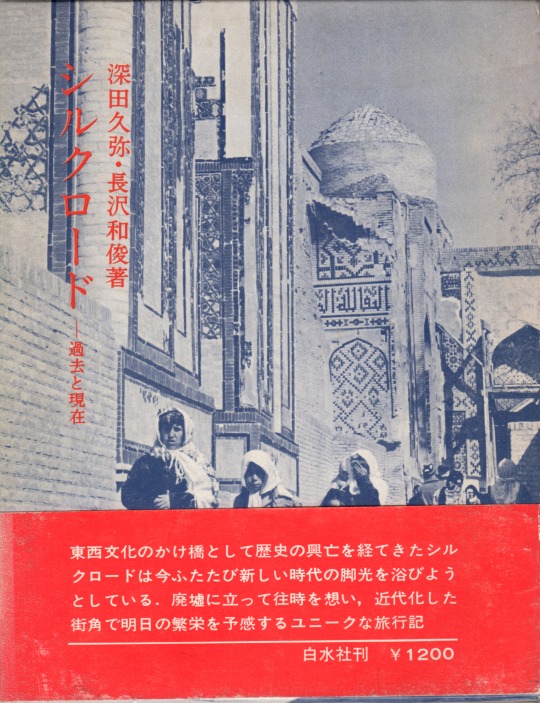
シルクロード-過去と現在 深田久弥・長沢和俊 白水社 函写真=撮影・関沢保治
#シルクロード-過去と現在#シルクロード#kyuya fukada#深田久弥#kazutoshi nagasawa#長沢和俊#関沢保治#anamon#古本屋あなもん#あなもん#book cover#函
21 notes
·
View notes
Photo




Go to Mountain !『FUJISYAGADAKE』
2 notes
·
View notes
Text
Bandai-san, Fukushima Prefecture
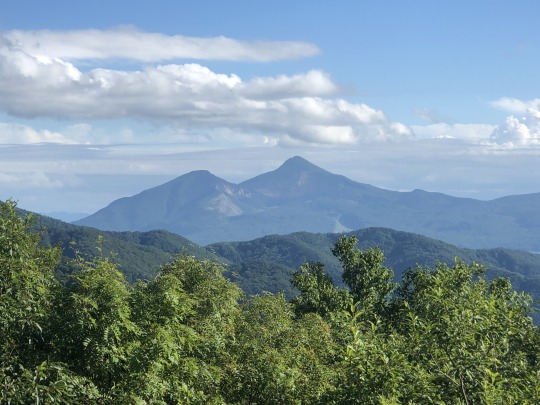
Bandai-san last erupted on July 15th, 1888. Dark ash rose 3-4 times higher than the summit, forming a giant mushroom cloud. Lava spewed from Ko-Bandai-san, the north peak and flowed down to Hibara village killing 500 people and 57 stock animals. 11,032 households were damaged or destroyed. Rivers were dammed and three large lakes were formed; Onogawa, Hibara and Akimoto. Disaster would later lead to good fortune. The area of devastation slowly became a tourist destination for future generations. This area, now called called Urabandai, became a National Park. The area is famous for sight seeing, especially when the shadow of Bandai-san can be seen reflecting on the lakes. While the views of Bandai-san from the north are rugged and comprised of various ridges and old lava flows, the views from the south fixate on a magnificent looking cylindrical cone. Bandai-san, which is based on the on-reading of 磐梯山 Kanji was originally named Iwa Hashi-yama, the kun-reading of the same Kanji. It is believed that the word Iwa Hashi, which roughly translates to boulder chair, derives from the clastic piles of volcanic rock debris that form a wall near the summit. Famous songs, haiku's and books have been written about Bandai-san, however it caught my attention because it resides in Kyuya Fukada's book Nihon Hyaku-meizan, which documents the "One Hundred Mountains of Japan," and for that reason I wanted to climb it.
A little over 134 years later, I landed in Narita and was greeted by my wife outside the gate. She had been in Japan over the past three weeks with our son Leif. We drove two hours to her childhood home in Utsunomiya. I met Leif outside of at a restaurant and he seemed somewhat unsure if it was really me. I picked him up and a wave of emotion went through me. We had been separated for far too long. Asaka and I were initially supposed to spend a romantic 3 night hiking trip up north together, but we both recognized that we would be happier if Leif joined. The extra effort of carrying him up each mountain would be worth it.
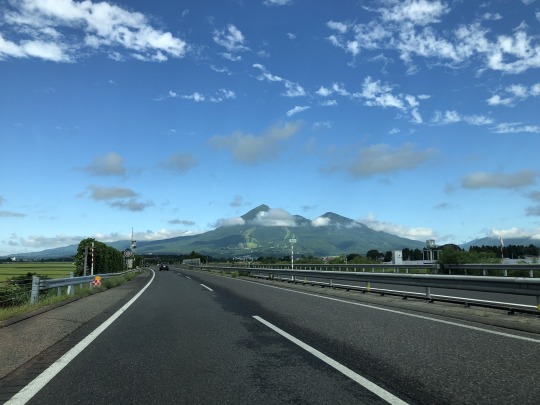
The next morning, Asaka, Leif and I drove two hours north to Inawashiro. Asaka plannedall the logistics so I left my weary, jetlagged brain on relax mode. She told me the hike would take two hours, so we were in no rush that morning. We arrived at the ski resort and purchased our lift tickets, saving us 1,500 feet of gain. I was a little worried the resort wouldn’t let Leif ride the chair lift, however this never ended up being a concern for any of the chair lifts we rode on the various mountains across out trip.
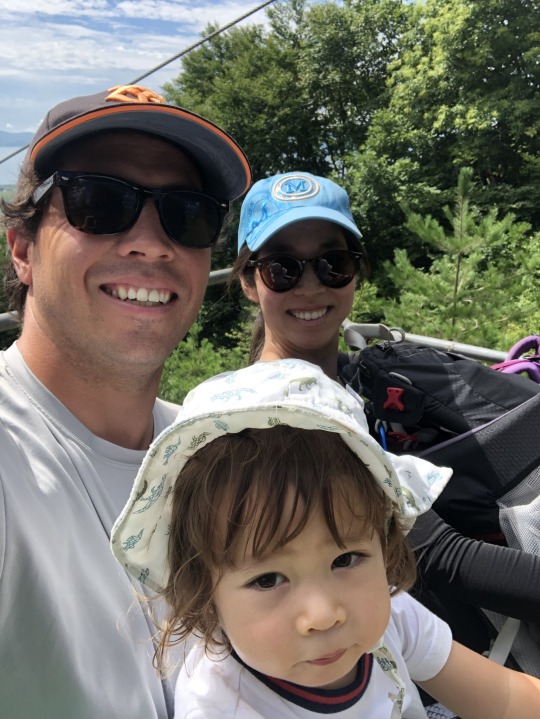
I rode solo with Leif on the second lift, since he clearly expressed that he wanted to sit on the chair rather than in my lap.
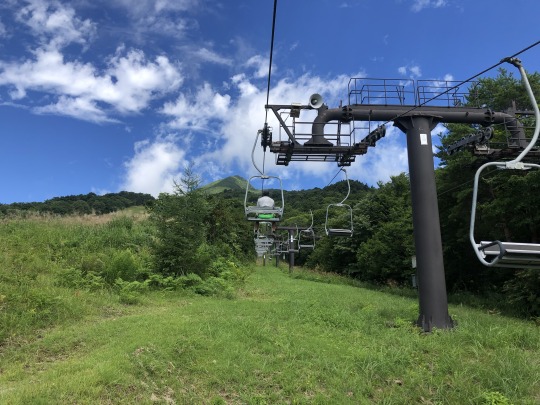
After a somewhat time consuming ride, we finally made it to the top of the second and final ski lift. Down below was Lake Inawashiro.

We had a quick lunch right there on the trail as we enjoyed the views. We then strapped Leif into the back of the carrier and we started up the steep trail.
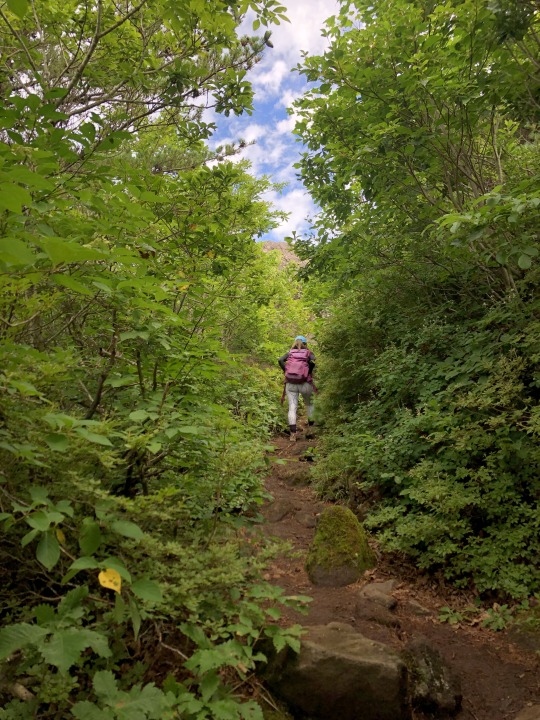
When packing for international flights, one often has limited space and has to make choices on what or what not to bring. I decided against bringing trekking poles, as they take up a lot of space, however now I was regretting it. Leif was now a toddler, and weighed much more than when he was an infant, so I could have used the poles for extra balance. The heat and humidity also became apparent. It took only a few minutes for me to become completely drenched in sweat.
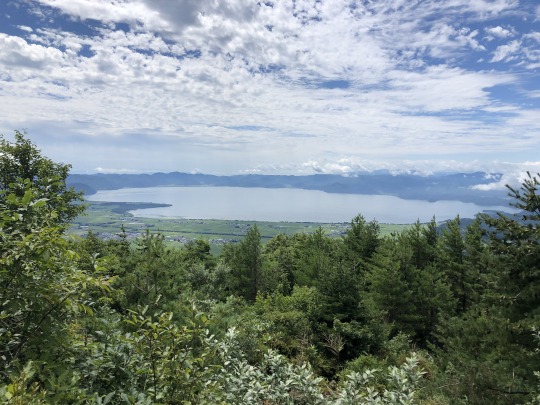
I studied the track as I struggled up the trail. I noticed the hike was broken up into 3 general sections; steep, gradual and steep. I was making slower progress than I expected, and I quickly realized that Asaka’s suggestion that the hike would take only 2 hours was dead wrong. We had to climb 2,300 vertical feet between the top of the ski lift to the summit. We would be lucky to make it to the top in two hours, especially considering that I had a kid on my back. Then there was Asaka, who was also carrying her own baby. She was more than 7 months pregnant, and in no condition to be straining her body. To make matter worse, Asaka informed me that the final lift down was scheduled for 2:10pm. I was not exactly happy with this update, but resolved to go through with it.
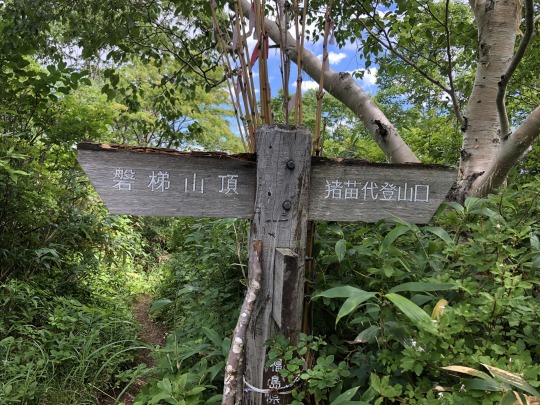
We passed underneath the bonus peak Akahani-san and after 0.9 miles we finished the first steep part of the hike. I had averaged just under 2 miles per hour after climbing about 800 vertical feet with the 30+ pound child on my back. This may seem slow, but I was a week removed from the Sierra Challenge, and in possibly the best hiking shape of my life. Asaka was a little bit quicker than me.
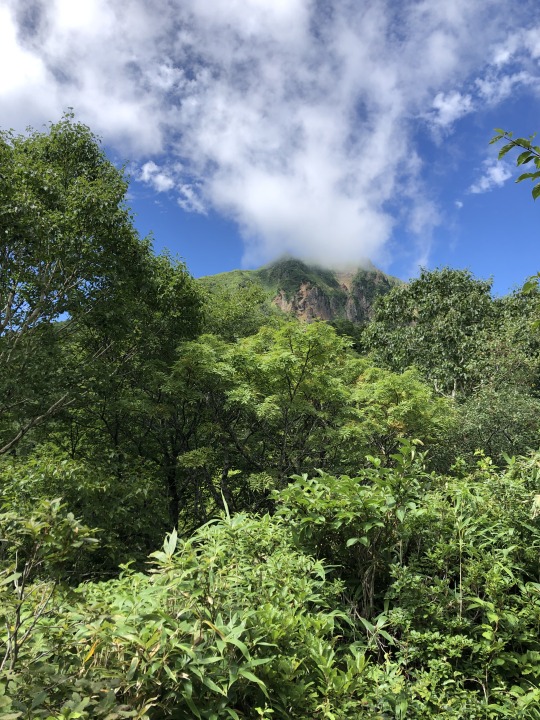
We then transitioned into the gradual section of the hike which was a great relief. We were able to pick up the pace here. There was water everywhere and the surrounding vegetation was a deep green. I felt like I was in a Jurassic Park movie. The trail passed alongside Numanohira Meadow, the location of an ancient crater that formed during an eruption that dates back to the year 806.
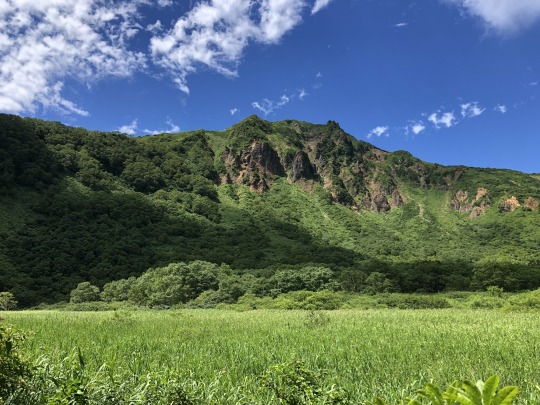
The gradual section ended after another 0.9 miles. I now had one final 0.9 mile push ahead of me, however it would be even steeper than the first section, entailing about 1,200 ft of vertical gain. I could do nothing other than put my head down and push.

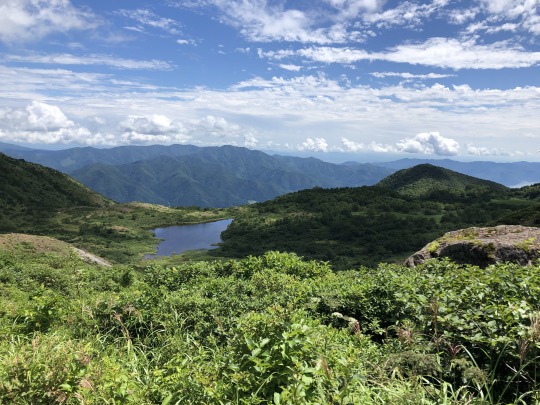
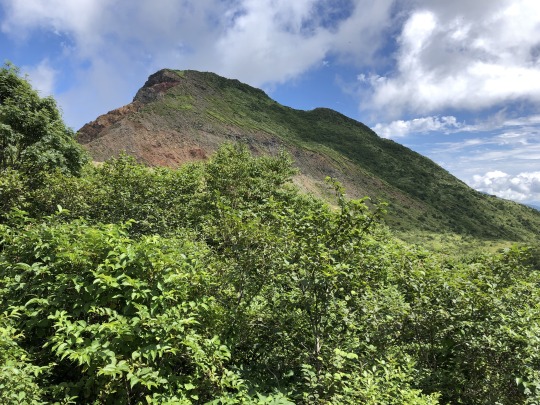
The ridge reached a saddle between Bandai-san and a very prominent bonus peak to the east. I followed the ridgeline as it climbed to the southwest.
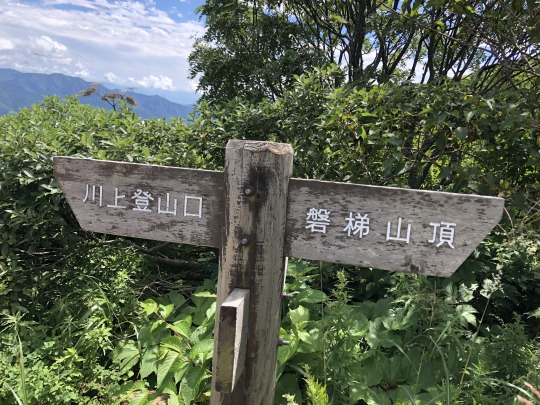
To the north were Lake Hibara and Nishi-Azuma-yama.
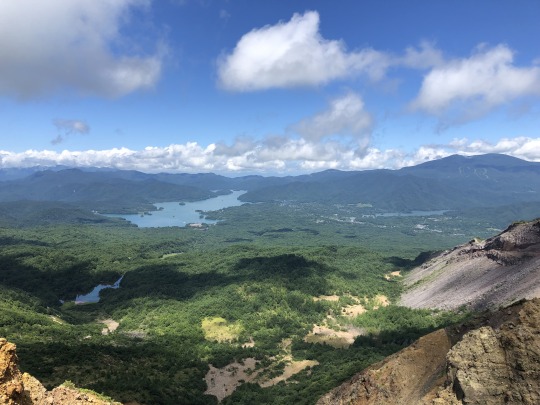
Even though we were both carrying babies, Asaka and I were the fastest up and down the mountain that day. Meanwhile, I was constantly bombarded with endless compliments from the other hikers; sugoi, kawaii, great father, etc. At first this was nice, but by hour 3 it was starting to get old. Meanwhile, Asaka hardly got any compliments, and I think only one other person on the mountain noticed she was pregnant.
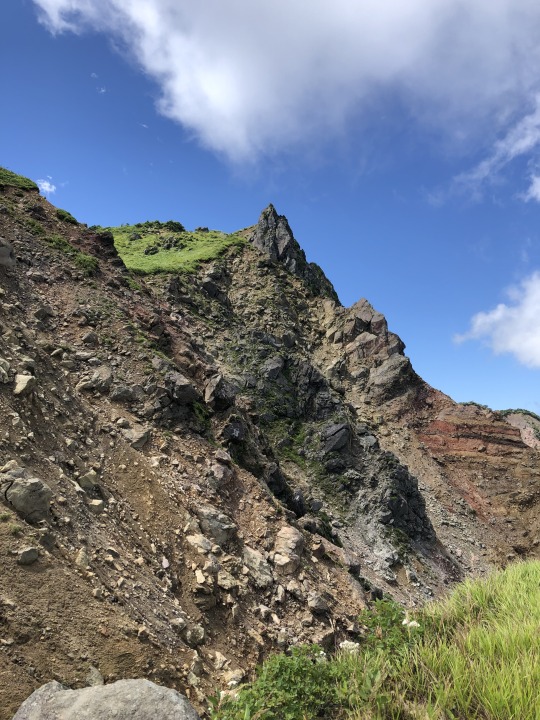
There was a hut as we neared the top, and large crowds were gathered here, either preparing for the final push or recovering from their earlier climb. This was typical Japanese Hyaku-meizan hiking. It’s hard to find a true wilderness experience while chasing the 100 Famous Japanese Mountains.

I now started to make headway in front of Asaka. I just wanted to get Leif to the top before he could start complaining, so I pushed hard.
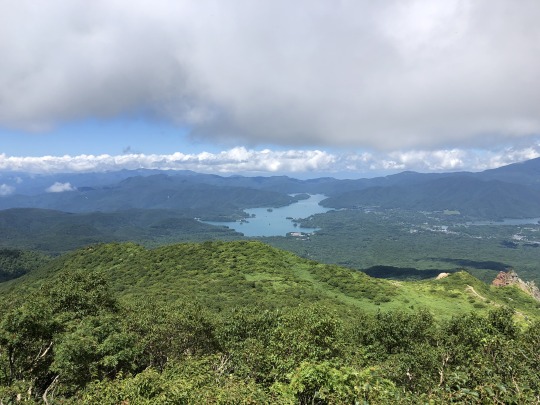
In the end I paced myself with a young child and her father. We passed almost everyone except for a couple people, who were freshly reenergized after buying an ice cream and a soda pop from the hut down below.
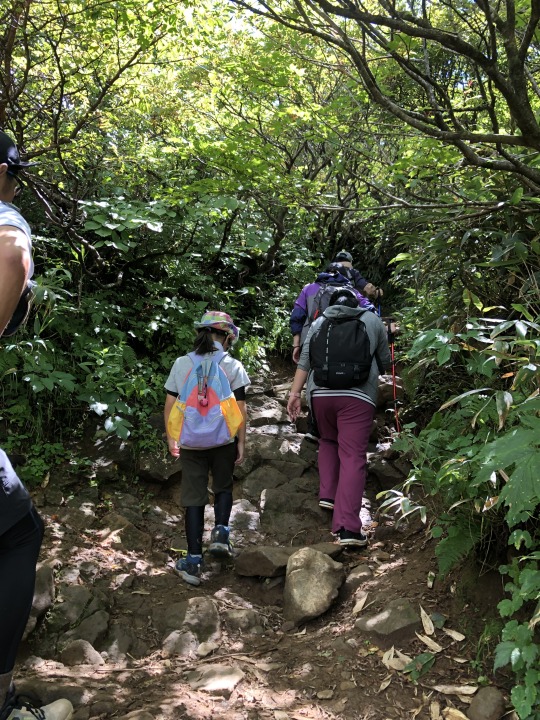
While the brush was cleared along the trail, this was done with short people in mind. I ended up having to bend over a lot so that Leif wouldn’t smash into the branches overhead.


I beat Asaka to the summit by about 10 minutes. I was drenched in sweat. The summit was covered with dragonflies and people, giving it a Colorado 14er feel.
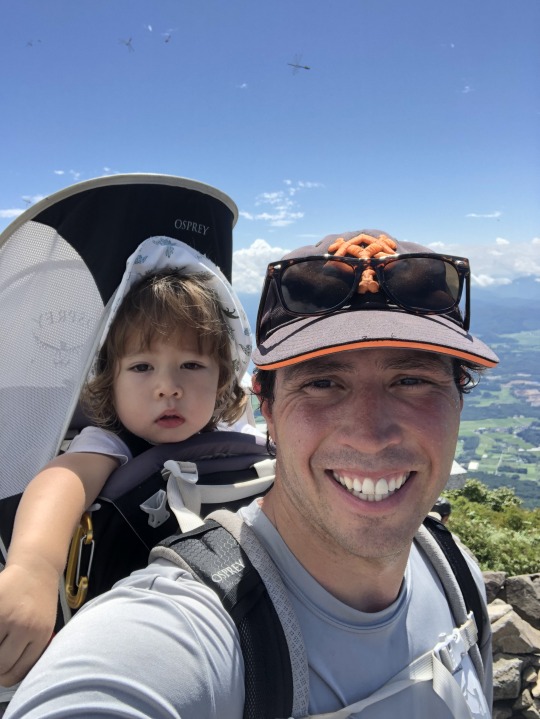
I took Leif out of the carrier and tried to drink some water, but Leif started crying. I couldn’t calm Leif down and I began to feel embarrassed as I looked like some stupid gaijin who couldn’t control his own kid. Finally Asaka joined us and we were able to calm him down.
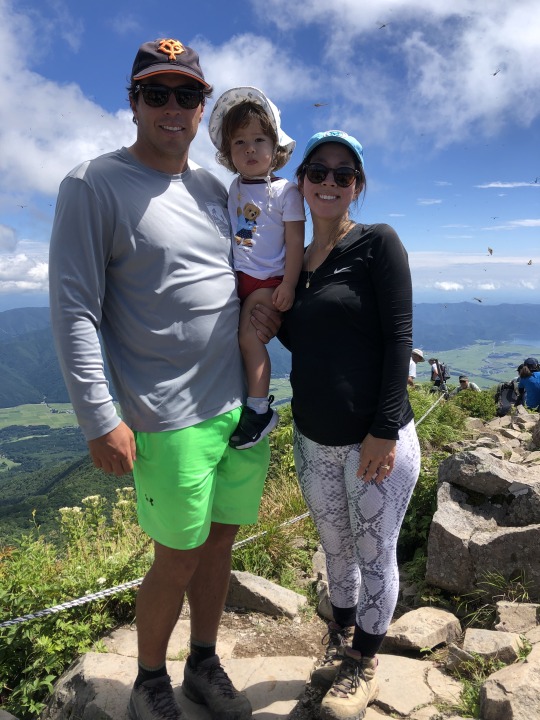
To the east were Minowa-yama, Tetsu-san and Adatara-yama.
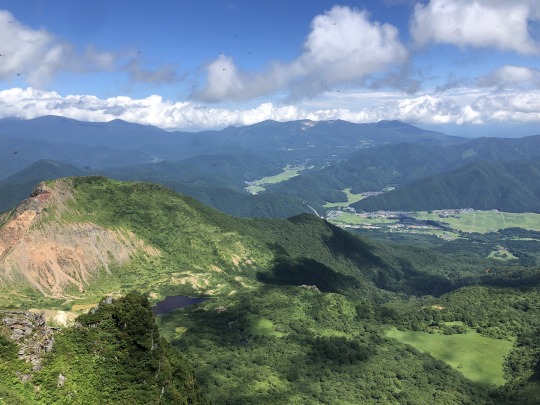
To the south was Lake Inawashiro.
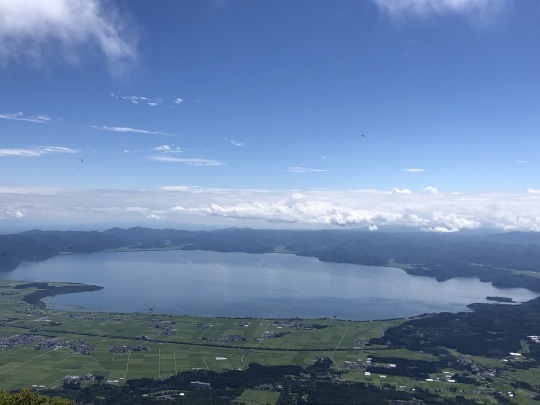
To the west was the Aga River Valley.
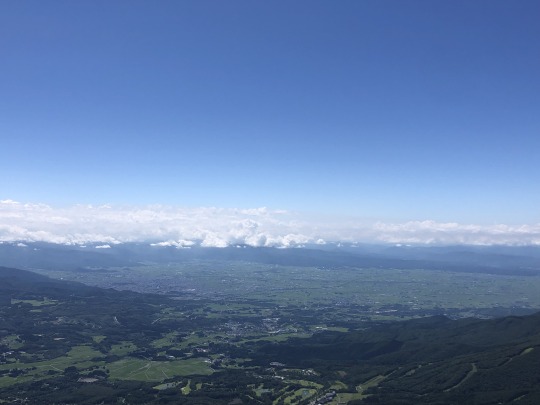
To the north was Lake Hibara.
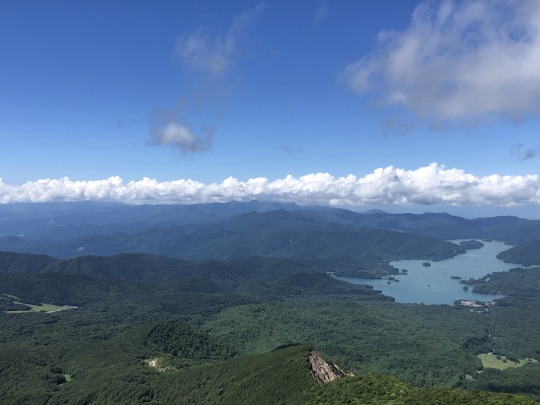
Asaka tried telling me that one of the lakes down below was connected to the Sea of Japan. What?? She’s lucky she’s pretty.
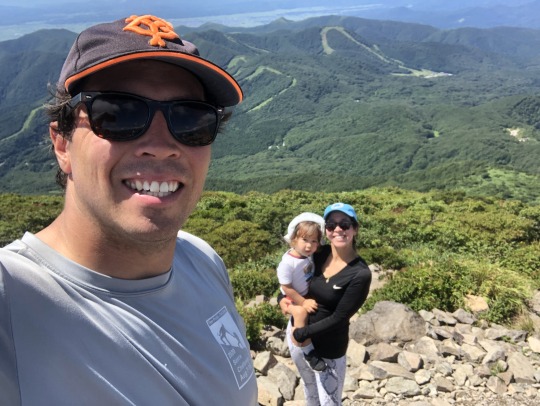
We had a little more than an hour to make it back down to the chair lift. We hurried as fast as we could, having to stop every few minutes for a traffic jam. It doesn’t seem like downhill has the right of way over here. Also people don’t move over. When given the opportunity, Asaka would shoot by every slow ojisan and obasan along the trail. There should be a rule where if a 7 month pregnant lady passes you, you should be banned from the mountain for at least a year. We stopped at a spring seeping directly out of the mountain. I was low on water and decided to fill up my water bottles straight from the source without treatment. The water was very fresh! Even with this extra boost, I doubted we were going to make it, and I did not want to hike down the ski run which was now a big grass hill. I was mostly worried about Asaka's condition, and I didn't want to push her too hard. Somehow, we made it back down to the chair lift at 2:06pm, giving us 4 minutes to spare.
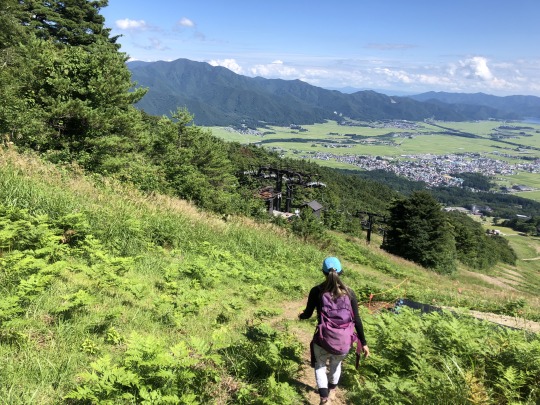
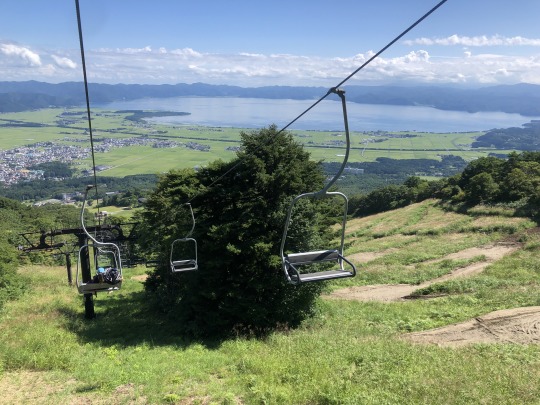
We had an enjoyable ride back down to the car.
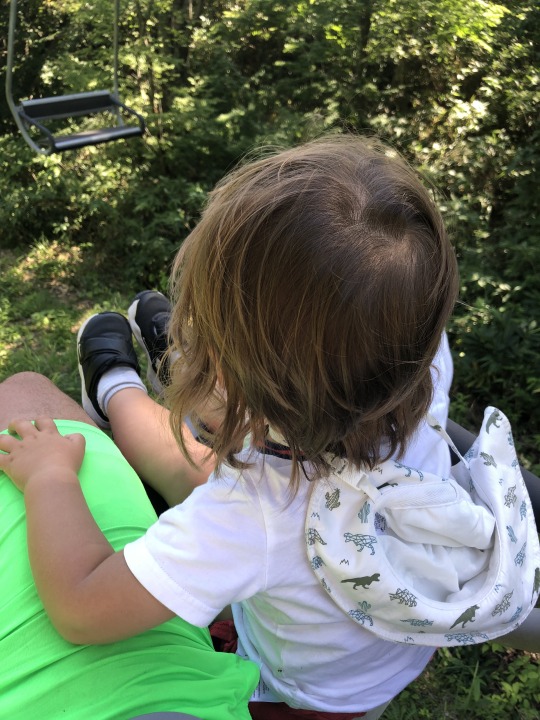
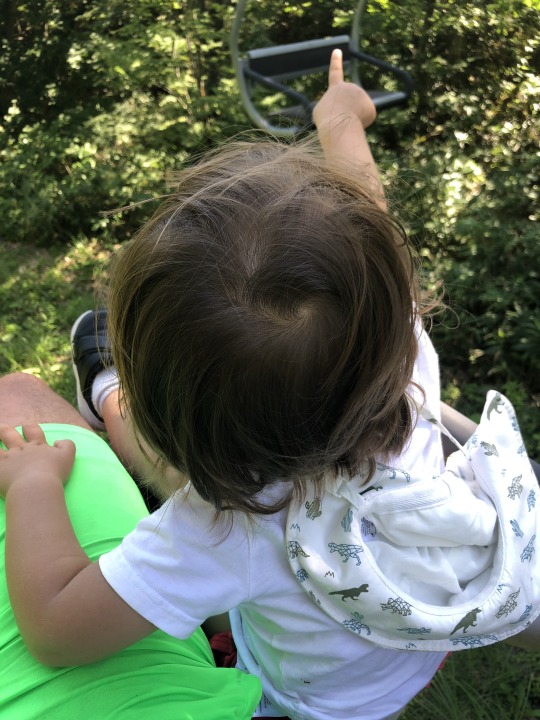
We even found some entertainment for Leif.
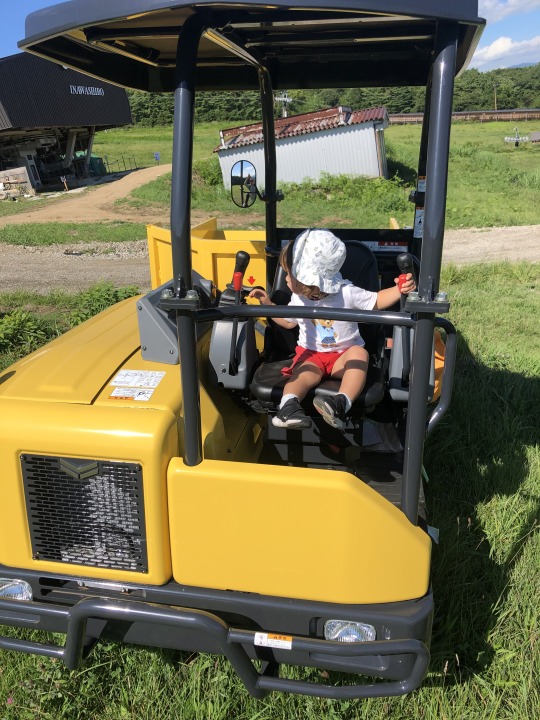
We were surprised to spot a troop of monkeys on our drive out.
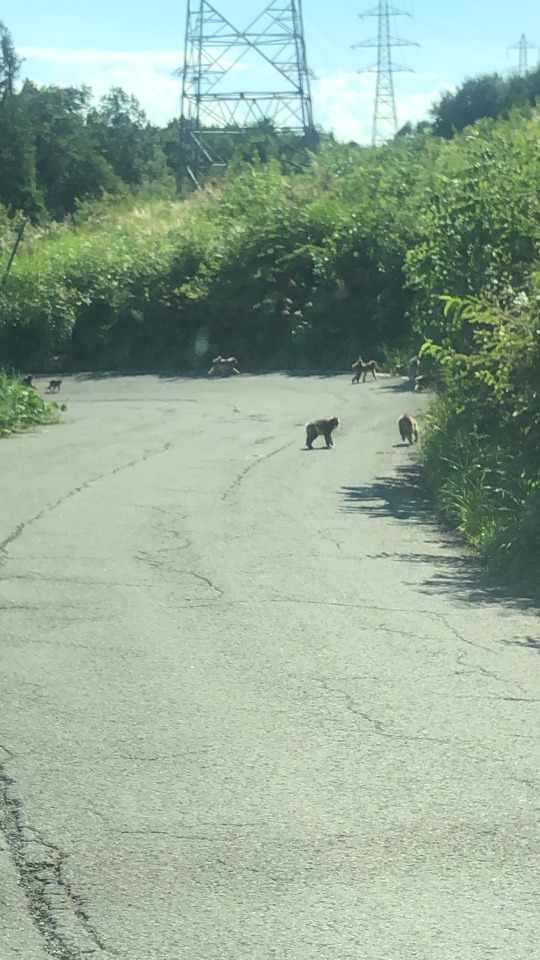
I would have liked to climb the two bonus peaks, but it was just too hot and we didn’t have enough time. Perhaps I could have done these if the trip was planned a little better, but that’s what happens when you delegate. We then drove an hour north to the onsen where we planned to sleep. It was an incredibly beautiful and peaceful place to spend the night.
0 notes
Text
Climbing Japan's 100 Famous Mountains
Climbing Japan's 100 Famous Mountains is now a must-do activity for hiking enthusiasts. The list is based on three criteria: the mountain must have a particular characteristic, be at least 1,500 meters high, and have a particular historical or cultural significance. Mount Fuji, which looms over Tokyo, has become one of the country's most revered mountains and has become a part of the Japanese spirit. It attracts more than 300,000 hikers every summer.
The 4th highest mountain in Japan is Aino-dake. Most hikers combine it with Kita-dake. This mountain has a unique summit hump. While it is not the most impressive mountain, it does offer some spectacular views of the surrounding area. On the western side of the mountain, there is also Mibu-dake.
Fukada, a writer and mountaineer, compiled this book in 1964. Although his original intention was not to make a list of the 100 most important mountains in Japan, his repertory has since become a must-have for mountaineers. Fukada began writing articles about mountains in the 1940s and published his first magazine called Hyaku meizan.
Akira Chiba has climbed Mount Yarigatake, the last of the 100 mountains in Kyuya Fukada's classic book. Climbing these mountains is a life goal for many Japanese mountaineers. The exhilaration of reaching the summit is a powerful experience, but Chiba is also committed to continuing to climb distant peaks.
In the northern Alps, Shirouma-dake is the first major mountain on the famous ridge run. There are two routes to reach the summit. You can also take a year-round snowfield or descend from the Kurobe Gorge. The summit is surrounded by gigantic huts.
Climbing Japan's 100 Famous Mountains is a must-do activity for any mountain enthusiast. The list was first published in 1964 and is now known as the Nihon Hyakumeizan (100 famous mountains of Japan). Fukada's list was based on three subjective criteria: grace, individuality, and history. He has been a mountaineer himself for years and is a member of the alpine club. Climbing these mountains is a personal dream for him.
Mount Fuji is Japan's most famous mountain and is revered throughout the world. It is the sacred symbol of the country and attracts thousands of pilgrims each summer to the shrine on the summit. The image of Mount Fuji has been reproduced throughout Japanese art. Hundreds of works of art feature the mountain, including the famous Thirty-Six Views of Mount Fuji, which was published between 1826 and 1833.
1 note
·
View note
Text
100 Famous Japanese Mountains
There are over 100 famous mountains in Japan, and each of them has a special place in the hearts of the Japanese people. Mount Fuji is one of these mountains. It is one of the country's most famous peaks and is easily accessible from Tokyo by train. The mountain was supposedly the home of immortality and was the subject of numerous works of art by famous artists. It is a volcanic mountain, and some of its peaks are active today. You can find more information about choosing a 日本百名山登山.
Fukuda's book is shorter than many modern essays on the Japanese mountains, and focuses more on their history than on the specifics of climbing. It isn't a guide to hiking in the mountains themselves, but instead focuses on the history of the mountains and their names. While it may not be as exciting as climbing on the mountain itself, it can help readers understand the significance of the mountains for Japanese society.
Fukada's list emphasizes the mountains in the Chubu region, including the mountain Mt. Kurikoma, which has a horse-like shape on its mountainside. In the winter, this mountain is a signal of the beginning of the planting season. During this time, the mountains of the Kinki region have many legends about them.
The list of 100 famous Japanese mountains was compiled by Kyuya Fukada in 1964. Although he did not set out to compile a list of the 100 most famous mountains, Fukada's repertory has grown to become indispensable over the past few decades. Fukada started writing about mountaineering as early as 1940, when he created his first mountain magazine, Hyaku meizan.
The list of 100 Famous Japanese Mountains has three basic criteria: height, particularity and accessibility. The list is a must for mountaineers in Japan. Crown Prince Naruhito, an avid mountaineer, wants to climb all of the peaks. The goal is to reach all of them in 48 days.
The Joetsu Mountains are a popular destination for climbers. With their weather-beaten terrain and ridgelines honed to a knife edge, the Joetsu mountains are a great choice for those who like a challenging mountain. In fact, one of the hardest Japanese peaks is Horse Mountain in Uonuma, which is just shy of two thousand meters. The peak is easy to access, but it is best climbed in the summer or fall.
In the north, there is a mountain called Hiuchi-ga-take that soars heavenward. The trail to the summit requires some effort and a head-high bamboo, but it is worth it. Whether you choose a mountain hike or a scenic hike, it will be a rewarding experience.
1 note
·
View note
Text
Climbing Japan's 100 Famous Mountains
Climbing Japan's 100 Famous Mountains is a short, informative book that explains the history of the country's most famous mountains. The author, Kyuya Fukada, is an experienced mountaineer and author who has climbed and written about many of the country's most impressive peaks. He has also included information on the origins of the mountain names. Check their site to know more details 百名山.
In order to qualify as a "famous mountain" in Japan, it must meet three criteria: it must be 1,500 meters or higher, have particularities, and be a popular destination for hikers. Crown Prince Naruhito is a mountaineer and wants to climb each of the country's 100 famous mountains. He is attempting to set a record for climbing all of these mountains in 48 days.
In the northern Alps, Shari-dake rises above Hakuba. It is one of the first big mountains you will find on the famed ridge run. You can approach the mountain through the year-round snowfield on the north side, or from the southern side via a gorge and alpine onsen. From the summit, you'll be rewarded with expansive views and stunning waterfalls.
The southernmost mountain in the Southern Alps, Tekari is another popular climb. While it's a big mountain, it's a beautiful place to climb. The only downside is that you'll have to climb through head-high bamboo. Nonetheless, the reward is worth the effort.
The mountains are connected to significant events in Japanese history and mythology. They hold a special place in the people's hearts. The mountains are often adorned with shrines that are hidden in the mountains' peaks. The mountains are a sacred location where people pray to avoid drought.
In addition to climbing the 100 most famous mountains, you can hike around the 88 Sacred Temples of the Shikoku Pilgrimage. Climbing these sacred sites in Japan is not easy. Aside from hiking the Saigoku 33 Temples of Kannon, the journey involves countless obstacles.
The Tsukubasan mountain is 877m high and the smallest of the Hyakumeizan range. It has a huge cable car to the top. The start of the climb is also very interesting - you start the climb by passing massive tori gates, temples, and an old lady armed with a katana.
1 note
·
View note
Text
The 100 Famous Japanese Mountains
The 100 Famous Japanese Mountains are a collection of mountains located across the country. They were created in 1964 by famous mountaineer Kyuya Fukada. While the list is by no means definitive, it is a useful guide for those interested in hiking in Japan. In fact, Crown Prince Naruhito is currently attempting to summit every mountain on the list! You can find more information about choosing a 日本百名山.
The list began as a book by mountaineer and writer Kyuya Fukada. Although the book did not set out to create a comprehensive list of Japan's mountains, it became indispensable over the next decades. Fukada was a writer and mountaineer who started writing articles in 1940 and later started publishing a mountaineering magazine.
There are about 18,000 mountains in Japan, and this list is only a tiny percentage of them. Therefore, it is very difficult to determine which mountains are truly the best. The best way to discover these beautiful mountains is to travel to them. If you haven't already, plan a visit. The list below includes many of the most popular and most beautiful mountains in Japan.
In Northern Tohoku, Mount Hayachine dominates the landscape. The mountain is famous for its pale blue Yu-gama crater lake. It has several trails leading off the mountain and into the surrounding hills. Thousands of visitors visit this mountain each summer. It has become one of Japan's most popular destinations for hikers.
The list also includes Mount Fuji. It is a mountain that many Tokyoites visit throughout the year. This mountain is a UNESCO World Heritage site. There are a variety of trails that are perfect for hiking and mountaineering. This list has become a must-see guide for hiking enthusiasts in Japan.
1 note
·
View note
Text
The 100 Famous Mountains in Japan
There are several books that describe the 100 Famous Mountains in Japan. One of the most popular is written by Japanese mountaineer and writer Kyuya Fukada. It was published in 1964 and won the Yomiuri Prize for biography. Fukada did not intend to compile a list of Japan's greatest mountains, but his repertory quickly became essential to those who love nature and travel. While the list is based on popularity and not geographical importance, it does contain several notable locations. You can find more information about choosing a 百名山.
The mountain is accessible from Shinjuku and is popular with locals. To avoid crowds, try going during weekdays. This mountain is often associated with the tengu, the legendary folk creatures from Japanese mythology. The tengu are believed to inhabit this mountain and have long noses. You can climb this mountain from the trailhead near Dake Onsen. Alternatively, you can take a train from Tokyo to Kyoto and spend the night at a traditional ryokan.
Another Japanese mountain that has a worldwide reputation is Haku-san. At 1,700 meters, the mountain's main peak is known as the "nipple mountain" and appears in the Man-yoshu. The poet Kotaro Takamura wrote about Mt. Adatara and made it famous. The mountain is also the location of the spiritual birth of a famous mountain girl, Chieko. The mountain's acidic hot spring provides a calming effect. There are many onsens and hotels in the area.
The northern Alps between Mount Nanakura and Mount Renge are another popular destination. The Funakubo-goya Mountain Hut is staffed by a warm old couple who makes hearty meals for mountaineers. They use edible wild plants in the preparation of their meals. A well-developed visitor center helps visitors to enjoy the views. Those interested in hiking and mountain climbing should take advantage of the diverse trails and huts available in the area.
The mountains in Japan are often connected to historical events, mythology, and religion. Many mountains are sacred, and people believe in gods or holy men who reside there. In Buddhism, mountains represent the reign of the gods and society. The mountains are also important symbols in the Japanese spirit. They are part of the Japanese spirit, and attracting nearly 300,000 visitors every summer. These mountains are all worth visiting. Consider all of them and plan your visit accordingly.
Another one of the Hundred Famous Mountains in Japan is Mt. Myoko. At 2,400 meters above sea level, Mt. Myoko is part of the Kubiki Sanzan, a mountain chain. The three mountains are connected by a ridge. The climbing exit is near Komatsu IC. The road to the summit is the Sasaka Peak Forest Road. It is a nine-kilometer-round hike. There are toilets at Maruyama no sho.
One of the Hundred Famous Mountains in Japan is Mount Fuji. This 78-mile-long volcano was formed by an earthquake around 286 bce. The age of the mountain is uncertain, but its base is approximately 65 million years old. The first eruptions took place after 700,000 years ago. As a stratovolcano, Mount Fuji rose between Komitake-yama and Ashitaka-yama.
1 note
·
View note
Text
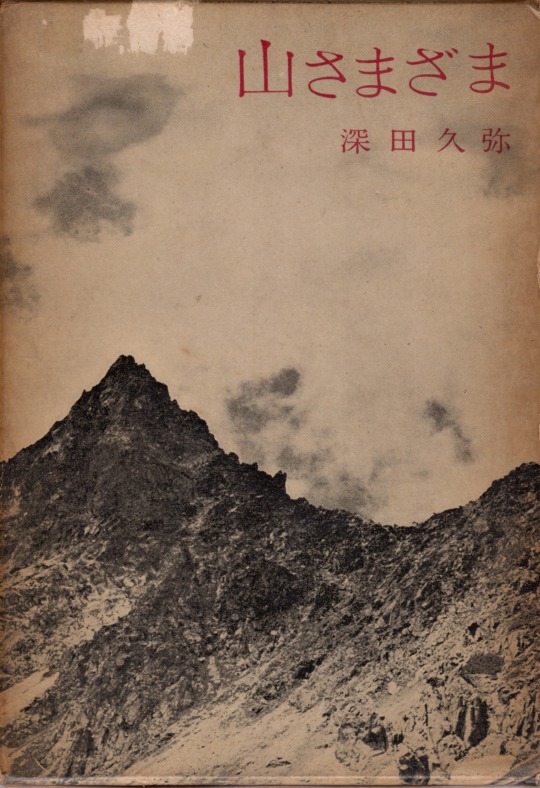
山さまざま 深田久弥 東西五月社 写真=浅野英司
48 notes
·
View notes
Text
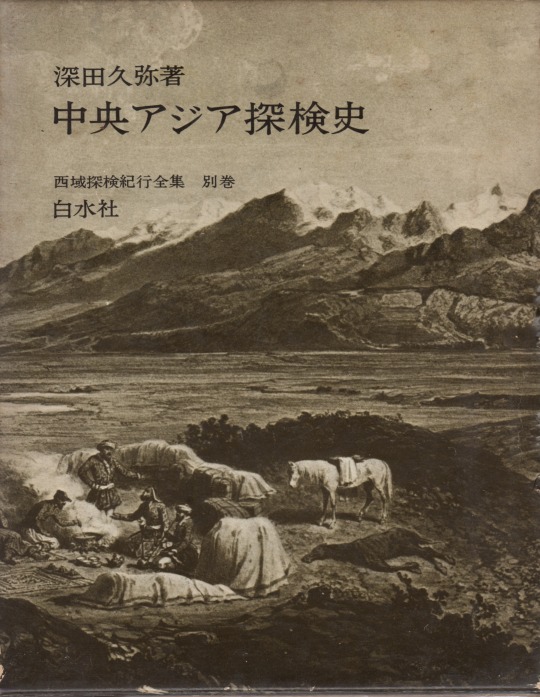
中央アジア探検史 深田久弥 西域探検紀行全集 別巻 白水社
6 notes
·
View notes
Photo
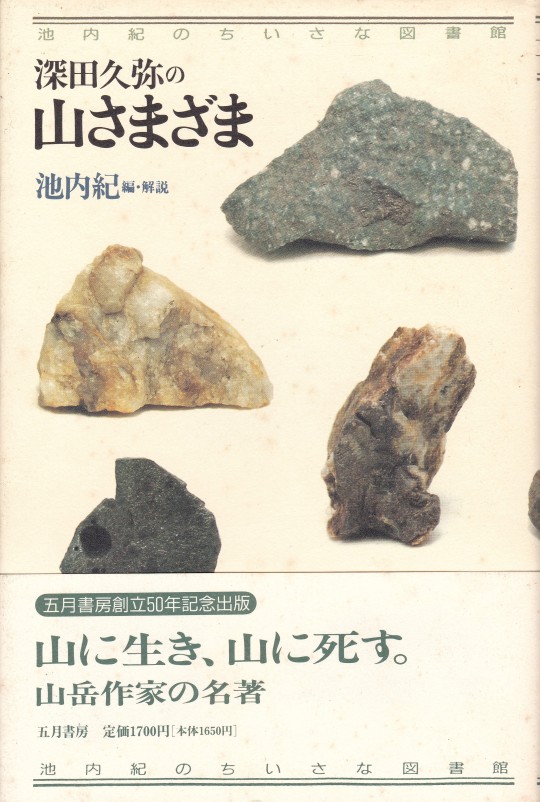
深田久弥の山さまざま 池内紀のちいさな図書館 池内紀=編・解説 五月書房 デザイン=田淵裕一
#深田久弥の山さまざま#kyuya fukada#深田久弥#池内紀のちいさな図書館#osamu ikeuchi#池内紀#yuichi tabuchi#田淵裕一#anamon#古本屋あなもん#あなもん#book cover
21 notes
·
View notes